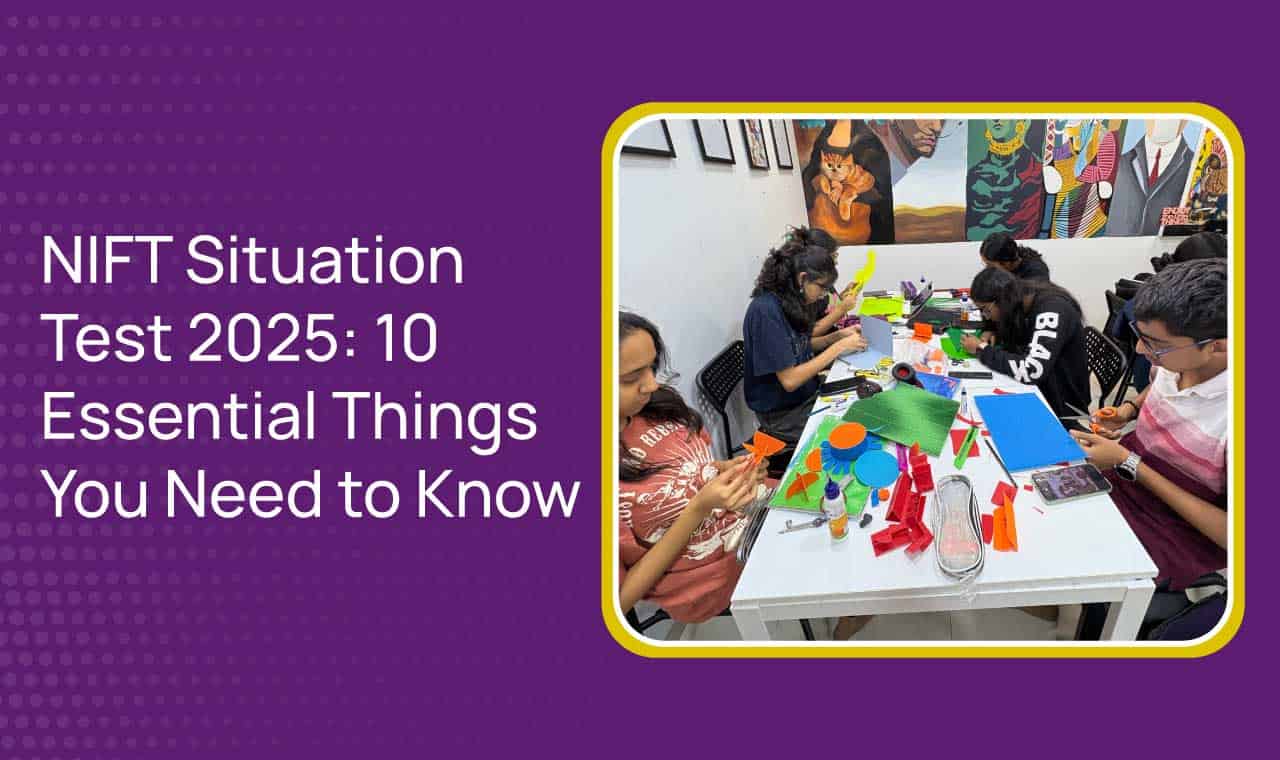
If you’re planning to get into the National Institute of Fashion Technology (NIFT), you’ve probably already heard about the Situation Test. It’s one of the most important steps in the admission process, and honestly, it’s where your creativity really gets put to the test. Unlike written exams, this one is hands-on and practical—it’s all about how well you can think on your feet, work with different materials, and turn your ideas into something tangible.
The Situation Test carries a lot of weight in the final selection, so it’s not something you can afford to take lightly. In fact, doing well here can be the deciding factor in getting that coveted seat at one of India’s top design institutes.
In this blog, we’ll explore things to know about the NIFT Situation Test 2025, including its structure, preparation tips, and common pitfalls to avoid.
Contact Us Now
A] What is the NIFT Situation Test?
The NIFT Situation Test is designed to evaluate candidates on their ability to conceptualise and execute a three-dimensional model using a given set of materials within a limited timeframe. You’re given some material (like paper, wire, fabric, clay) and a limited amount of time to build something based on a theme or problem statement. It’s not just about how pretty your final design looks—it’s about your creativity, your problem-solving skills, and how well you can bring your ideas to life. It’s almost like stepping into a real-world design scenario, where you have to think on your feet and make the most of what you’ve got.
Here’s what it assesses:
-
Creativity and Innovation
This is where you get to wow them. The more unique and interesting your ideas are, the better. It’s about creating something that stands out—not just for how it looks but also for how well it solves the problem or fits the theme. Basically, they want to see how “out of the box” you can think while keeping your design practical and meaningful.
-
Material Handling
The materials you’re given are often simple and straightforward, but that’s where the challenge lies. You’ll need to show that you can take basic stuff and generate art ideas to turn it into something impressive. How you cut, fold, combine, or shape these materials says a lot about your resourcefulness and attention to detail.
-
Time Management
With only 2–3 hours to complete the test, candidates must balance speed with precision. This time management requires careful planning and efficient execution to ensure they finish on time without compromising on quality.
B] Key Details About the 2025 NIFT Situation Test
To perform well, it’s essential to understand the structure and expectations of the NIFT Situation Test 2025. Here are ten important aspects to keep in mind:
-
Test Format and Structure
The NIFT Situation Test typically involves creating a 3D model based on a specific theme or prompt, such as “Design a Sustainable Community Center” or “Create an Innovative Workspace.” Candidates are provided with a set of materials and must use them to bring their ideas to life.
-
Evaluation Criteria
Assessors focus on several factors, including:
- Creativity and originality of the concept.
- How effectively the materials are used.
- Aesthetic appeal and finishing of the model.
- Practicality and relevance of the design to the theme.
- Quality and clarity of the accompanying concept write-up.
-
Duration and Process
Candidates are usually given 2–3 hours to complete the test. This timeframe includes brainstorming ideas, sketching a rough plan, executing the model, and writing a brief explanation of the concept.
-
Importance of Mock Practice
Mock tests are essential for familiarising yourself with the test’s time constraints and materials. Practising regularly under simulated test conditions helps build confidence and improve speed and accuracy.
-
Material Handling Techniques
Common materials provided during the test include coloured paper, fabric swatches, clay, thread, straws, and more. Developing skills in cutting, folding, glueing, and shaping these materials is crucial. For instance, learning how to create intricate folds with paper or crafting sturdy structures with straws can set your model apart.
-
Concept Write-Up Requirements
In addition to the model, candidates must submit a write-up explaining their design. This write-up should clearly outline the idea, the problem being addressed, and how the model solves it. A concise, well-structured explanation can add depth to your work and boost your score.
-
Weightage in Final Scores
The Situation Test carries significant weight in the overall NIFT admission score. It is often the deciding factor for candidates who are close in their Creative Ability Test (CAT) and General Ability Test (GAT) scores.
-
Location and Schedules
The situation test NIFT 2025 is conducted at designated NIFT campuses across India. Candidates must check their assigned location and stay updated on official announcements regarding test dates and timings.
-
Key Dates to Remember
Important dates, such as test schedules, admit card releases, and result announcements, are published on the official NIFT website. Keeping track of these dates ensures you don’t miss critical deadlines.
-
Common Pitfalls to Avoid
Some of the most common mistakes candidates make include:
- Spending too much time on one aspect of the model leaves others incomplete.
- Failing to align the design with the theme.
- Using too many materials can make the model appear cluttered.
- Overlooking the importance of the write-up.
Also Read: Creating An Effective Fashion Portfolio As A NIFT Student – Essential Tips
C] Preparation Tips for NIFT Situation Test 2025
Preparation is key to acing the Situation Test. Here are some tips on best practices for NIFT situation test:
-
Analyse Past Test Topics
Reviewing themes from previous years can give you a sense of what to expect. Past prompts often revolve around contemporary issues, sustainability, or creative problem-solving. Analysing these topics can help you anticipate the kind of challenges you may face.
-
Practice with Diverse Materials
Experimenting with different materials allows you to understand their properties and how to use them effectively. For example, practice creating sturdy structures with straws or crafting intricate details using paper and clay. This will help you adapt to whatever materials you’re given on test day.
-
Develop Time Management Strategies
Allocate specific time slots for brainstorming, execution, and finishing. Practising under timed conditions helps you strike the right balance between speed and quality. For instance, dedicate 20 minutes to planning, 90 minutes to execution, and 10 minutes to finishing touches.
-
Work on Presentation and Finishing Skills
A neat and well-finished model can make a lasting impression. Pay attention to details like clean edges, symmetry, and overall aesthetics. Remember, even the most creative idea can lose its impact if the execution is sloppy.
-
Learn to Create Unique Designs
Originality is crucial. Avoid reusing clichéd ideas like flower vases or lamps unless you can innovatively present them. Focus on creating designs that reflect your personal style and unique perspective.
-
Write Concise, Clear Concept Explanations
Practice writing short, effective explanations for your models. Your write-up should clearly communicate the purpose of the design, the problem it addresses, and the thought process behind it.
-
Attend Workshops or Seek Expert Guidance
Enrolling in workshops or seeking feedback from mentors can help you identify areas for improvement. Experts can also share tips on material handling, ideation, and presentation. You can also join art classes in Mumbai to get expert guidance for preparation.
-
Avoid Overused Ideas or Themes
Think beyond the obvious. For example, if the theme is “Sustainability,” instead of creating a simple recycling bin, consider a modular eco-friendly workstation or a biodegradable packaging solution.
Contact Us Now
Conclusion
The NIFT Situation Test is more than just a practical exam—it’s a platform to showcase your creativity, design thinking, and problem-solving skills. Excelling in this test requires a combination of strategic preparation, consistent practice, and a focus on originality.
By analysing past trends, practising with diverse materials, and refining your time management skills, you can ensure a strong performance. Remember, the key is to think creatively, execute efficiently, and present your ideas effectively. With the right approach, you can make a lasting impression and take the next step to achieving your dream of studying at NIFT.

Komal Ullal
Ms. Komal Ullal, a recipient of the prestigious President’s Award and Co-founder of UAF, is an expert in student profiling, enhancing artistic skills, mentoring in design thinking and an inspiring women entrepreneur. With an impressive collection of 577 awards—including 196 trophies and 109 medals—earned in drawing and painting at both national and international levels, she was featured in the Limca Book of Records in 2007 as the youngest achiever of such accolades. Her passion and dedication continue to inspire budding artists and designers worldwide.

